Taro is known by so many different names around the world and its history dates back to ancient times. In ancient Hawaiian culture for example, only men were allowed to work with the taro plant. More recently, the Tsukimi Japanese festival which honours the fall harvest moon, includes taro as one of the main menu options.
In this guide, we’ll share all things taro, including the varieties and their spectacular different leaf colours, propagation techniques, some care tips, and also more info about taro as a food source.
More...

Family: | Araceae |
|---|---|
Genus: | Colocasia |
Species: | C. esculenta |
Origin: | Southeast Asia |
Common Names: | Taro, eddo, dasheen |
Location: | Indoor and outdoor |
Type: | Small herbaceous plant |
Growth: | Up to 1.5 metres tall and 1 metre wide |
Sun requirements: | Partial shade |
Foliage Colour: | Variety dependent but includes light and dark green, black and purple |
Flower Colour: | Cream and yellow, similar to calla lily |
Flowering: | Infrequently |
Edible Parts: | The corms, leaves and stems can be eaten if cooked |
Maintenance level: | Low |
Poisonous for pets: | Yes |
What is Taro?
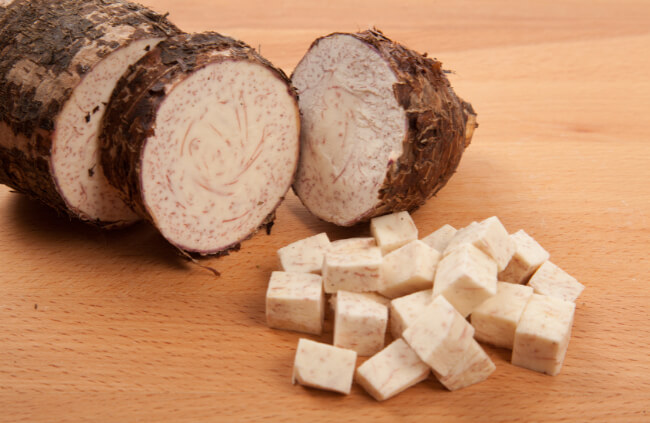
Taro is often known as eddo, elephant ear, or dasheen. Belonging to the arum family of plants, the corm (underground food storage stem) can be eaten. Taro is native to Southeast Asia and from there made its way around the Pacific islands as a main food source.
The plant was often called taro root and was grown for the big and starchy underground stems. These are used as a cooked vegetable, but are also an ingredient for desserts and bread, and the leaves are usually stewed.
It’s important to note that the leaves and the corms of the taro are poisonous so you can’t eat it raw. The cooking or heating process is what gets rid of the calcium oxalate.
Popular Taro Varieties
Colocasia esculenta ‘Black Coral’

Source: Perennial Resource
A taro that has black or purple leaves that are big and glossy. The leaves have blue veins that are quite easily spotted.
They are also heart-shaped and wrinkled in appearance. This taro is more glossy and reflective than the Black Magic variety.
Colocasia esculenta ‘Black Magic’
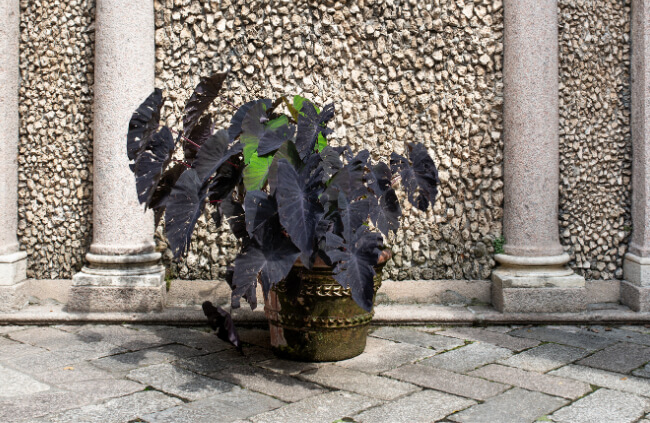
A taro with purplish-black leaves and burgundy colour stems. The colour of the leaves is dependent on how much sunlight the taro gets and can range from dark green to a dark purple that looks almost black.
This taro is similar to the Black Coral variety but the leaves are more matte and with a ruffled look.
Colocasia esculenta ‘Fontanesii’

Source: Online Plant Guide
This taro has glossy leaves that are bright green to blue in colour. The leaf veins are dark green and the stems are a purple-black colour.
This variety produces bright yellow flowers. It’s quite hardy compared to some of the taro varieties.
Colocasia esculenta ‘Hilo Bay’

Source: Garden Center Marketing


Get Your Free Guide:
Master Growing Australian Natives eBook
A Must Have Complete Guide for Every Australian Garden
Get Your Free Guide:
Master Growing Australian Natives eBook
A Must Have Complete Guide for Every Australian Garden
This taro has leaves that are dark green and light green. The leaves have a textured effect and look almost crinkled. The stems of the Hilo Bay taro are a dark purple colour.
Colocasia esculenta ‘Illustris’
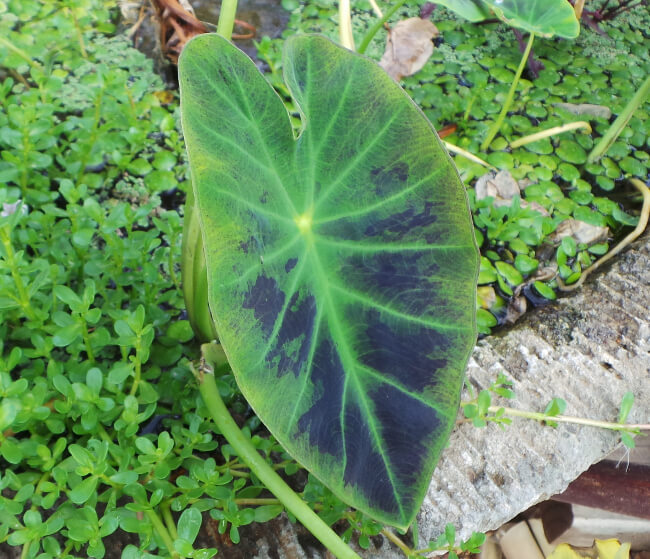
Source: Woodvale Fish & Lily Farm
This taro sometimes produces a yellow flower. It has large, heart-shaped leaves that have a bronze colour with bright green veins.
It’s a more tender taro variety so if possible let it spend winter time indoors.
Colocasia esculenta ‘Mojito’
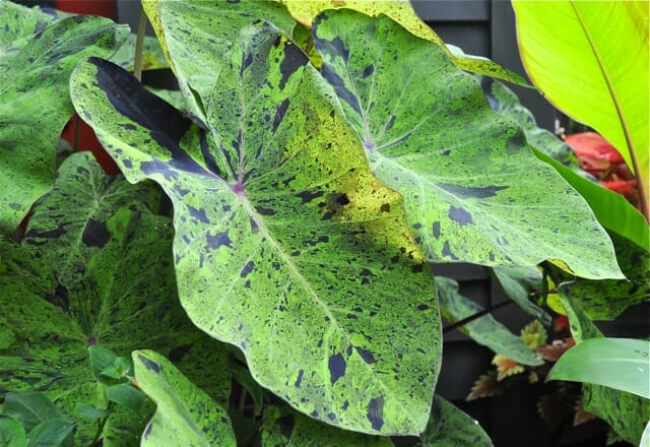
Source: A Way to Garden
This taro has light green leaves and a purple speckled effect on the leaves. Each leaf has its own pattern and partial sun exposure brings out the colour of the leaves. The appearance of this taro is lush.
Colocasia esculenta ‘Rhubarb’

Source: Fine Gardening
This taro has green leaves shaped like a spade, are large, and have a red dot in the middle. Rhubarb taro has thin stems that are a reddish pink colour. It grows to a maximum height of 1.2 metres
Popular Taro Varieties
Colocasia esculenta ‘Black Coral’A taro that has black or purple leaves that are big and glossy. The leaves have blue veins that are quite easily spotted. They are also heart-shaped and wrinkled in appearance. This taro is more glossy and reflective than the Black Magic variety. |  Source: Perennial Resource |
Colocasia esculenta ‘Black Magic’A taro with purplish-black leaves and burgundy colour stems. The colour of the leaves is dependent on how much sunlight the taro gets and can range from dark green to a dark purple that looks almost black. This taro is similar to the Black Coral variety but the leaves are more matte and with a ruffled look. |  |
Colocasia esculenta ‘Fontanesii’This taro has glossy leaves that are bright green to blue in colour. The leaf veins are dark green and the stems are a purple-black colour. This variety produces bright yellow flowers. It’s quite hardy compared to some of the taro varieties. |  Source: Online Plant Guide |
Colocasia esculenta ‘Hilo Bay’This taro has leaves that are dark green and light green. The leaves have a textured effect and look almost crinkled. The stems of the Hilo Bay taro are a dark purple colour. |  Source: Garden Center Marketing |
Colocasia esculenta ‘Illustris’This taro sometimes produces a yellow flower. It has large, heart-shaped leaves that have a bronze colour with bright green veins. It’s a more tender taro variety so if possible let it spend winter time indoors. |  Source: Woodvale Fish & Lily Farm |
Colocasia esculenta ‘Mojito’This taro has light green leaves and a purple speckled effect on the leaves. Each leaf has its own pattern and partial sun exposure brings out the colour of the leaves. The appearance of this taro is lush. |  Source: A Way to Garden |
Colocasia esculenta ‘Rhubarb’This taro has green leaves shaped like a spade, are large, and have a red dot in the middle. Rhubarb taro has thin stems that are a reddish pink colour. It grows to a maximum height of 1.2 metres. |  Source: Fine Gardening |
How to Grow Taro in Australia
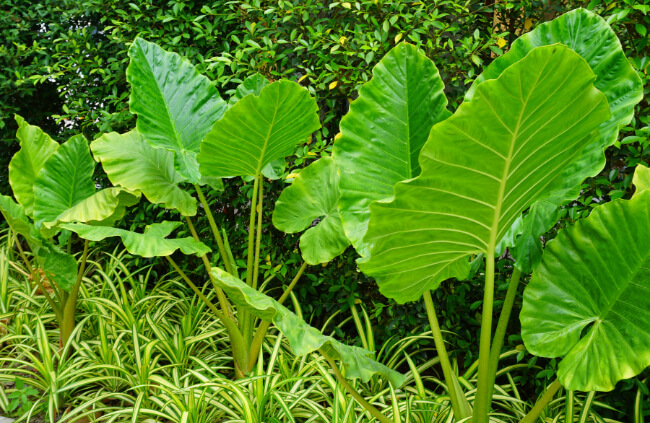
Taro likes to grow in partial shade with some sunlight filtering through. Grow it in a soil that is moist and rich and don’t let it dry out. Taro also needs to be protected from strong winds. This plant isn’t celebrated for its flowers, but rather the leaves that can be a variety of different colours.
Taro will grow happily in the shade of other trees and adds a tropical feel to the garden. It works well as a houseplant and thrives in a pot too.
How to Propagate Taro
The ideal way to cultivate Taro is through root division or using corms. If you aren’t able to get what you need from an existing mature plant, you can use corms that you have bought from a supermarket. Ensure you choose ones that don’t show any signs of mould or rot.
Once you have the corms in hand, you need to figure out which is the top and which is the lower half. The top of the corm usually has something that looks eye-like and the lower end is usually shaped in more of a point.
It’s the bottom pointed part that needs to be facing down when you plant the corm in a suitable mix and put it into position. If you can’t figure out the top from bottom you can plant the corm on its side.
You’re aiming to plant the corms about 5 to 8 cm below the soil and if you’re planting a few together, be sure to space them at least 60 cm apart. The corms will do best somewhere warm. If you are planning to plant them outside then spring is the best time. Allow for a time period of up to 200 days for full maturity.
Best Conditions for Planting Taro

Sunlight
Taro needs partial and indirect sun. If you are keeping your taro inside, just make sure it gets sufficient bright light.
Soil
The soil needs to be rich and well-draining and always remain moist. Include lots of organic matter and remove weeds quickly. The preferred pH range is 5.5 to 6.5 for achieving healthy growth.
Fertiliser
We recommend using a liquid fertiliser during the growing season, and you can fertilise every 3 weeks.
Water
Water your taro regularly as it enjoys wet soil and high humidity. For taro grown indoors, you can mist the leaves often.
Pruning
When you notice that the stems of your taro are yellow or brown, that’s your cue to prune.
Harvesting and Consuming Taro
Taro is known as a root vegetable and the corms are a food staple for African and South Asian cultures. There is sufficient evidence to show that taro is one of the earliest plants to be cultivated. In Cyprus for example, taro has been enjoyed since the Roman Empire.
The modern name for it is kolokasi, and it forms part of a well-known casserole dish, but has also become popular for being deep fried to make chips. Nigeria is the biggest taro producer worldwide and it’s a type of crop that can be grown in a flooded area or landscape like paddy fields.
How to Eat Taro
The edible parts of taro are the corm and leaves. The corms are best enjoyed roasted, baked or boiled, and they have a sweet and nutty flavour profile. It’s often used as baby food thanks to fine grains and starch that can be easily digested.
The leaves and stems of a young taro plant can be eaten, but first need to be boiled twice. This gets rid of the unpleasant flavour. The leaves are rich in vitamin A and C and packed with protein.
Taro is toxic in its raw state due to calcium oxalate, but the cooking process makes it safe for consumption. You can also soak the plant in cold water overnight to neutralise the toxins.
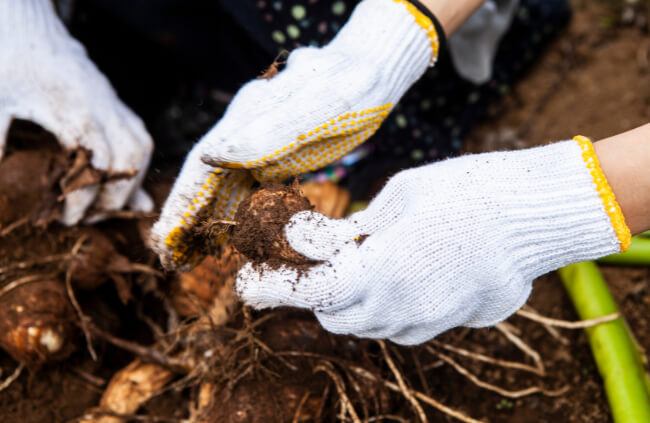
How to Harvest Taro
Generally, taro should be ready for harvesting within 7 to 12 months after being planted. It does depend on the variety, but when the leaves are starting to yellow and die back, you can go ahead and harvest by digging up the tubers.
The tubers will only last about a month in storage so we recommend eating them as soon as possible after harvesting. For the taro leaves, you can start picking once the first leaf has opened up. Take a few leaves for each harvest, and don’t remove all the leaves off the plant at the same time.
Possible Taro Pests and Diseases
Phyllosticta leaf spot
The first signs of this disease are small spots that can be brown, black or grey. The spots get bigger over time and sometimes join together. Sometimes these spots fall out of the leaves and leave a hole. You might notice that the leaves become yellow and start to drop.
At the beginning of spring, you can fertilise your taro if it’s been affected by leaf spot and then prune to help encourage better circulation. Any dead parts of the plant can be removed.
Phytophthora root rot
This disease causes the leaves of the taro to wilt and turn yellow. You might also notice fewer leaves and signs of dieback. You can treat your plant using hydrogen peroxide. A 3% solution of household hydrogen peroxide applied to your soil is great to kill off diseases like Phytophthora.
You can use a mixture of 1 part peroxide to 3 parts water. Give it time to sink into the soil before watering again.
Northern Armyworm
The larvae of these army worms are green with stripes on their bodies. These pests cause damage by chewing on the leaves and creating a scalloped effect on the margins of the leaf. You can treat with a neem oil spray which helps to manage the different stages of larvae.
Make sure you cover your plant well, especially on the underneath of the leaves. If you need something a little stronger to control an infestation, you can use an organic insecticide.
White spotted flea beetle
These beetles feed on the leaves and stems of the plant and create little pits and small holes. You can use strong smelling plants to deter the beetles. These include sage and mint.
Whitefly
Whitefly and aphids work in much the same way, removing plant liquids and creating a sticky honeydew. This can then cause sooty mould on the leaves as well. The leaves of the plant wilt and become pale and yellow. You’ll notice stunted growth and the leaves might even fall off.
You can start by using a good strong spray of water to shake up the whiteflies. It will help to loosen up the nymphs and eggs. You can follow up with a spray made at home to keep the pests under control.
Mix up some dishwashing liquid and water, and then spray your plant at the end of the day. If you find the infestation of whiteflies is still unbearable, you can gently use a handheld vacuum twice a week to get rid of them. Also, read our in-depth guide on how to get rid of whiteflies for more treatments to choose from.
Lace bug
These pests feed on the underneath part of the leaves. They suck fluid from the plant which causes a pale and bleached look on the leaves. Neem oil will work well as a treatment and you can make up your own spray at home.
Use one teaspoon of neem oil for every litre of water. You can spray the leaves that are under attack every 2 weeks.
Frequently Asked Questions About Taro

Where does the species name for taro come from?
The species name esculenta is Latin for ‘edible’ or ‘good to eat’.
Where does the more common name taro come from?
It comes from the Maori language when Captain Cook first discovered Colocasia plantations in 1769. The name Taro is often used in Polynesian languages.
Is Taro considered an invasive plant?
Taro is considered an invasive plant in Hawaii, Florida, Singapore, Taiwan, and New Zealand, and is classified as an environmental weed in Queensland, New South Wales and south-western Western Australia.
What precautions should be taken for Taro in its raw form?
It is advised to wear gloves when you are touching the corm and leaves of the plant as they can irritate the skin. You’ll need to keep an eye on your pets when growing taro as it can cause toxicosis if they eat it.
Is taro popular as an ornamental plant?
It is often grown as an ornamental plant in the UK and has earned itself the Royal Horticultural Society’s Award of Garden Merit.
What does it mean if there is leaf damage in the early growth stages?
First check the roots of the plant to make sure they are healthy. If this isn’t the problem, it’s possible that your soil doesn’t have enough nutrients to encourage plant growth. Sometimes, cold temperatures or too much heat can cause this effect as well.
Want to explore more edible plants? Sign up for our newsletter.
Wrapping Up Our Taro Growing Guide
Taro is a hearty plant that doesn’t require too much care. It can be grown in a multitude of places, indoors or outdoors. Being able to harvest taro to use in your cooking is wonderful, along with the many health benefits.
Published on June 4, 2023 by Maisie Blevins
Last Updated on February 23, 2025





Does taro grow well in southern NSW and Victoria?
Hi Joe,
Taro is a tropical plant, but grows fairly happily in subtropical conditions. If you can provide some sort of microclimate, either with a walled section of the garden, or some overhanging foliage to lock in heat and humidity it should grow pretty well.
If not, you could always grow Taro indoors or in a greenhouse. We had a friend who managed to grow it quite well up against the house on the patio in Tasmania, so it’s definitely worth a go.
All I’d say is that direct rainfall might be a problem. Even in subtropical settings, it grows on really well drained soils. It’s the humidity it needs, so try to control its growing spot through late winter if you can. Or, simpler yet, bring it indoors when it drops below 25-35°C.
Best regards,
Maisie Blevins